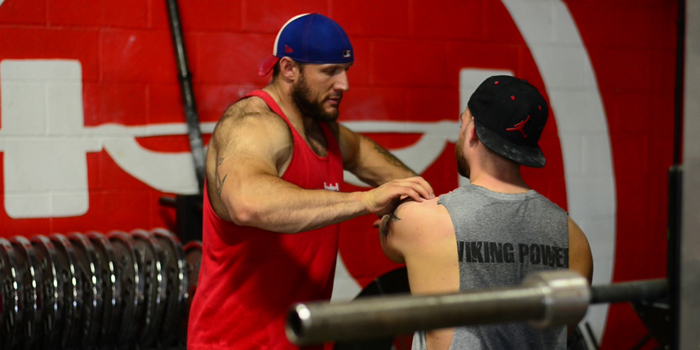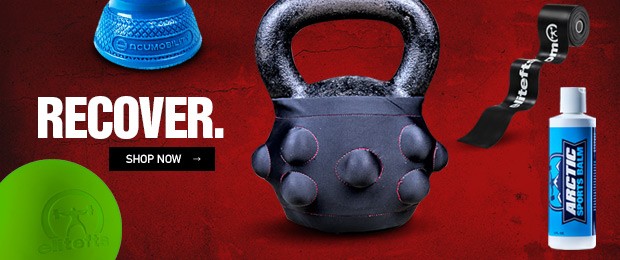
In part one I reviewed three lower body mobility and stability drills you can perform prior to your training that won’t take all day. In part two I am going to address the upper body. These drills are quick, simple, and effective!
These drills will focus on three of the most common dysfunctions associated with powerlifting, bodybuilding, and strength sports. These dysfunctions most commonly include latissimus dorsi tightness, excessive lumbar extension coupled with poor thoracic extension and rotation, and poor shoulder stability and mobility (external and flexion focus). These are the most common dysfunctions I have seen in a clinical setting. However, keep in mind that others can also occur.
Thoracic Extension with Eccentric Lat Lowering
Bodybuilders, powerlifters, and strength athletes with dysfunction are not the best at actively accessing new ranges of motion. On the other hand, what we are good at is resisting a weight into a new range of motion. So, let’s use that intermuscular coordination and put it to use with an eccentric focus to help lengthen our fudged up lats.
RECENT: Priorities for the Powerlifter and Bodybuilder — Lower Body Mobility and Stability
The lats act as one of the biggest stabilizers when it comes to strength and power in the big three. In bodybuilding competitions, shows are won from the back, so having a thick, wide, and dense back is a goal for every physique. When volume, intensity, and load are all added without proper programming, tightness, poor range of motion, and decreased muscular activation (from fascial restrictions) can occur. The lats originate from the thoracic T7-T12, 9th to 12th ribs, lumbar and sacral vertebrae (via thoracolumbar fascia), and most importantly relating to our issues, the posterior third of the external lip of the iliac crest. This means the lats have a large effect on lumbar and sacral position. The tighter the lats, the more extension the lumbar and sacrum can be pulled into.
Points of emphasis:
- Maintain tension through the anterior core by creating a neutral position between your ribcage and pelvis. Avoid extension at any other area other than the thoracic spine.
- Tuck the chin to keep a neutral cervical spine and avoid excessive extension.
- Eccentrically focus on lowering the lats while exhaling forcefully and with a 2:1 ratio to your inhale. For example, inhale for three seconds and exhale for six seconds.
- Continue to move up your thoracic spine repeating the exercise, ensuring you gain extension through the entire area. Use a half foam roller or half PVC pipe if the extension is too much.
Half-Kneeling Shoulder Controlled Articular Rotations (CARS)
This is an exercise created by Dr. Andrea Spinae and his FRC method. The goal here is to create proximal stability to yield distal mobility. We need to learn how to create tension within the anterior core to allow shoulder (glenohumeral) and scapular (scapulothoracic) mobility to occur. This requires daily sessions performed with perfect execution and zero compensation. The ability to maintain proper ribcage to pelvic position throughout the movement will dictate the effectiveness of this exercise. Keep thoracic and lumbar position while properly breathing. This will affectively allow the scapula to rotate around the ribcage (scapulothoracic movement) and the shoulder joint (glenohumeral) to move through circumduction. This should be completed on both sides and in forward (flexion) and backwards (extension) ranges.
Points of emphasis:
- Maintain tension and the proper relationship between rib cage and pelvis. This will equate to proper thoracic extension and lumbar stabilization.
- Keep the down leg glute (leg closest to the wall) flexed and slightly posteriorly tilted the entire time.
- Control your breathing through the entire range of motion.
- Be sure to not use momentum or use the wall for assistance.
- Focus on controlling your arm through points of tension, not rushing through them.
Dead Bug with Isometric Push/Pull
As we move closer to the main upper body exercise, we want to start integrating our push and pull movements with stability so we are primed and ready to go. This last exercise uses isometric push and pull muscle contractions in conjunction with the dead bud position to lock in core stability and bring everything together. Establishing a proper lumbar position via a neutral pelvis and packed rib cage will create a more effective position for the push/pull action to take place. Once you have established your core position, begin breathing into the push or pull action while maintaining the dead bug position. Do this for 30 seconds to one minute for one to three rounds.
Points of emphasis:
- Establish and control a neutral rib cage and pelvic position.
- Maintain a constant diaphragmatic breathing rate.
- Keep a slight posterior tilt and your knees and ankles at 90 degrees.
- Keep your head in a neutral position, in line with your spine.
- Push or pull into the barbell at 80% for 30 seconds to one minute and repeat one to three times.
Dead Bug with Isometric Push
Dead Bug with Isometric Pull
There you have it, three simple mobility and stability drills that you can perform prior to any upper body day. These address some of the common dysfunctions and compensations associated with powerlifting, bodybuilding, and strength athletes.











Thank you for the kind words and I'm glad the article was beneficial. Hope it helped, and thanks for coming back to elitefts.com !